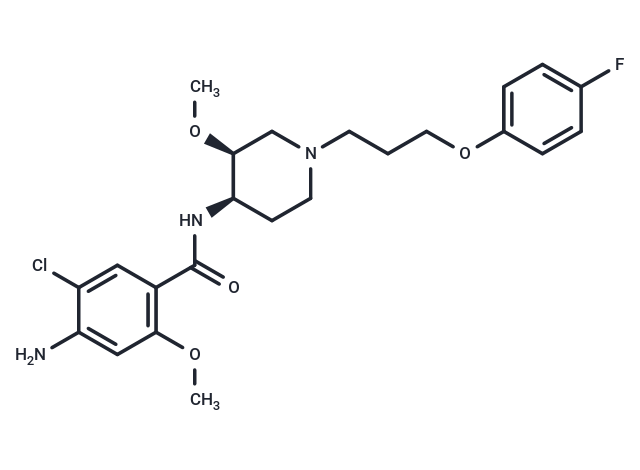Shopping Cart
- Remove All
 Your shopping cart is currently empty
Your shopping cart is currently empty

Cisapride (R 51619) is a serotonin type 4 (5-HT4) receptor agonists are potent prokinetic agents that act on serotonin receptors in the intestine and promote intestinal peristalsis, increase gastric emptying and decrease esophageal reflux.

| Pack Size | Price | Availability | Quantity |
|---|---|---|---|
| 5 mg | $39 | In Stock | |
| 10 mg | $54 | In Stock | |
| 25 mg | $70 | In Stock | |
| 50 mg | $100 | In Stock | |
| 100 mg | $137 | In Stock | |
| 200 mg | $247 | In Stock | |
| 500 mg | $415 | In Stock | |
| 1 mL x 10 mM (in DMSO) | $50 | In Stock |
| Description | Cisapride (R 51619) is a serotonin type 4 (5-HT4) receptor agonists are potent prokinetic agents that act on serotonin receptors in the intestine and promote intestinal peristalsis, increase gastric emptying and decrease esophageal reflux. |
| Targets&IC50 | 5-HT4 receptor:140 nM(EC50), ERG channel (human):9.4 nM |
| In vitro | Cisapride inhibits vascular Kv current independently of serotonin 5-HT4-receptor activation[2]. As HERG channel blocker, cisapride, can inhibit the growth of gastric cancer cells by altering distribution of cell cycle and inducing apoptosis so as to be of potential value in the treatment of gastric cancer. Cisapride could inhibit the growth and clonogenicity of human gastric cancer lines by specific blockage of HERG channel in a time- and dose-dependent manner while has little effects on GES cells[3]. |
| Cell Research | Cells in the logarithmic growth phase are harvested and seeded in 96-well plates. The cell number is diluted to 5000/well in 200 microliters of RPMI1640 medium. In vitro experiments are carried out on the gastric cancer cell lines and GES cell line, using an MTT proliferation assay. MTT stains live cells, and the optical density absorbance at 490 nM wavelength correlates with the cell number. Cisapride is added to the cells at concentrations of 0, 12.5, 25, 50, 100 or 200 nM and equivalent volume of ethanol is added as control in order to eliminate the effects of solvent. Twenty microliters of MTT is added to each well of the cell culture 4 h before termination of the culture at 37?C. One hundred and fifty microliters of dimethyl sulfoxide is added to each well at the end of the culture and the plate is agitated for 10 minutes. The absorbency at 490 nm is read by a BIOHIT BP800 plate reader. Growth curve is drawn according to MTT colorimetry. The inhibition rate is calculated.(Only for Reference) |
| Alias | R 51619, Pridesia, Prepulsid, Kinestase, Kaudalit, (±)-Cisaprid |
| Molecular Weight | 465.95 |
| Formula | C23H29ClFN3O4 |
| Cas No. | 81098-60-4 |
| Smiles | C(N[C@H]1[C@@H](OC)CN(CCCOC2=CC=C(F)C=C2)CC1)(=O)C3=C(OC)C=C(N)C(Cl)=C3 |
| Relative Density. | 1.29 g/cm3 |
| Storage | Powder: -20°C for 3 years | In solvent: -80°C for 1 year | Shipping with blue ice. | ||||||||||||||||||||||||||||||
| Solubility Information | DMSO: 45 mg/mL (96.58 mM), Sonication is recommended. | ||||||||||||||||||||||||||||||
Solution Preparation Table | |||||||||||||||||||||||||||||||
DMSO
| |||||||||||||||||||||||||||||||

Copyright © 2015-2024 TargetMol Chemicals Inc. All Rights Reserved.